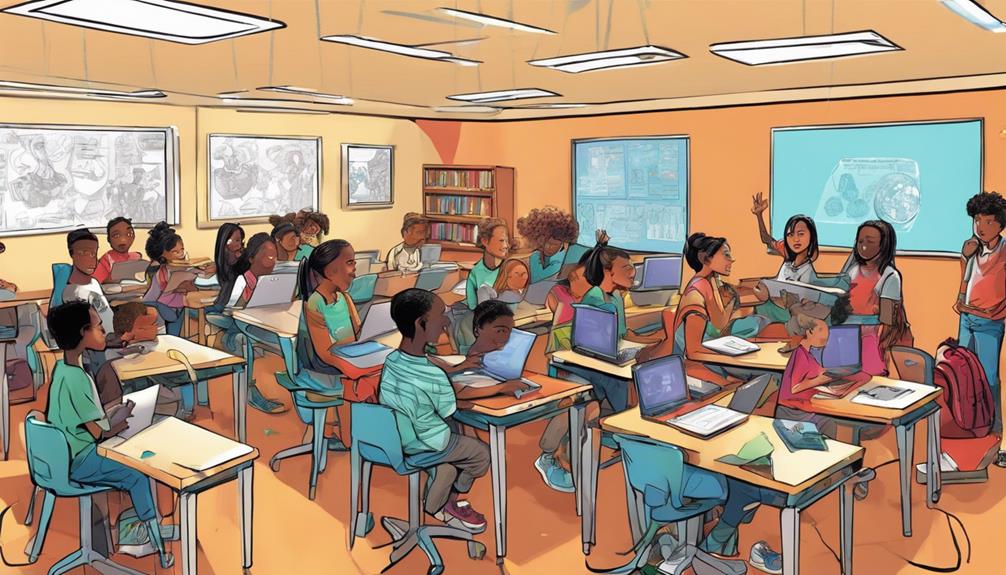Creating a serene classroom oasis starts with a bright spot close to natural light. Go for comfy furniture, like bean bags. Use sensory tools to boost focus. Add reflection activities, like journaling, for personal growth. Set up a mindfulness routine to ease stress. A soothing space boosts emotional health and academic success by offering a cozy, safe area. These together make a peaceful setting that enhances well-being and school performance. More tips and insights on crafting a perfect classroom oasis await you.
Key Takeaways
- Prioritize natural lighting near windows for a tranquil atmosphere.
- Choose ergonomic seating to support proper posture and comfort.
- Incorporate sensory tools like bean bags for tactile stimulation.
- Encourage self-reflection activities with learning journals and Me Tree exercises.
- Establish a structured mindfulness training program for stress management.
Location and Lighting Considerations
When designing a serene classroom oasis, selecting an appropriate location with ample natural lighting is paramount for creating a calming environment conducive to relaxation and focus. Natural light has been proven to positively impact mood and productivity, making it essential for a peaceful learning space.
Choose a spot near a window or with bright overhead lighting to maximize the benefits of natural light. Avoid areas with harsh fluorescent lighting, as it can be harsh and disruptive. By prioritizing good lighting in your classroom oasis, you are setting the foundation for a tranquil atmosphere that promotes student well-being and academic success.
Comfortable Furniture and Sensory Tools

Selecting ergonomic seating options and tactile sensory tools is essential when creating a serene classroom oasis. This ensures that students have comfortable and engaging resources for relaxation and focus. Ergonomic chairs that support proper posture can prevent discomfort during long periods of sitting, promoting better concentration.
Additionally, incorporating bean bags, floor cushions, or rocking chairs can offer alternative seating choices for students to find their preferred relaxation method. Sensory tools like stress balls, fidget spinners, or textured objects provide tactile stimulation, aiding in sensory regulation and stress relief.
These tools can help students stay calm and focused, enhancing their overall well-being in the classroom environment. By carefully choosing comfortable furniture and sensory tools, educators can create a calming space that promotes student engagement and relaxation.
Self-Reflection Activities for Students

Incorporating self-reflection activities for students is a valuable component of creating a serene classroom environment that fosters introspection and emotional well-being.
By providing tools like learning journals and self-reflection acronyms, students can engage in activities such as the Me Tree exercise and online journaling to enhance their self-awareness. These resources encourage students to explore their thoughts, emotions, and experiences, promoting personal growth and insight.
Utilizing reflective journal resources can further support students in developing a habit of introspection, leading to improved emotional regulation and overall well-being.
Mindfulness Training and Routine Establishment

Creating a structured mindfulness training program and establishing a consistent routine for students is vital in promoting emotional well-being and self-awareness in the classroom. Mindfulness training helps students develop skills to manage stress, focus better, and regulate their emotions effectively.
By incorporating mindfulness practices into the daily routine, students can learn techniques such as deep breathing, body scans, and guided meditation. Routine establishment is essential for reinforcing these practices, ensuring that students have dedicated time for mindfulness exercises each day.
Consistency in timing and duration of these sessions helps students cultivate a habit of mindfulness, leading to long-term benefits for their mental health and overall well-being. Implementing mindfulness training and routine establishment strategies can greatly contribute to creating a serene and supportive classroom environment.
Importance of a Calming Classroom Oasis

Establishing a calming classroom oasis is essential for cultivating a conducive learning environment that promotes emotional regulation and well-being among students. A serene space can greatly impact students' stress and anxiety levels, leading to improved focus and concentration.
By creating a safe and comforting environment, students can better manage their emotions and feel more at ease during the learning process. It also enhances overall well-being and mental health, contributing to a positive classroom atmosphere.
Key elements to take into account in setting up a calming classroom oasis include:
- Choosing a quiet, well-lit area with comfortable seating and sensory tools
- Incorporating nature elements
- Keeping the space organized and clutter-free
These factors help create a peaceful sanctuary where students can relax and recharge.
Frequently Asked Questions
How Can Teachers Address Students Resistant to Using the Calming Corner?
Address student resistance to the calming corner by acknowledging their feelings, promoting the benefits of the space, offering choices, ensuring privacy, and gradually introducing the concept. Encourage open communication, understanding, and patience to foster acceptance and utilization.
Are There Guidelines for Incorporating Technology in the Calming Corner?
Incorporating technology in the calming corner can enhance relaxation and self-regulation. Consider interactive mindfulness apps, calming music playlists, or guided meditation videos. Make sure devices are used mindfully and promote a balanced approach to technology usage.
What Strategies Can Teachers Use to Encourage Consistent Self-Reflection?
To encourage consistent self-reflection, teachers can employ strategies like integrating reflective journal prompts, fostering a routine for introspection, introducing mindfulness concepts, and offering a variety of engaging activities. These practices promote self-awareness and emotional regulation in students.
How Can the Calming Corner Support Students With Sensory Processing Disorders?
The calming corner can support students with sensory processing disorders by providing a designated space for sensory regulation. Including sensory tools, comfortable seating, and a quiet environment can help students manage sensory input, reduce stress, and promote emotional well-being.
Are There Options for Incorporating Movement-Based Activities in the Calming Corner?
Incorporating movement-based activities in the calming corner can be beneficial for students' sensory needs. Consider options like yoga poses, stretching exercises, or simple movement breaks to promote relaxation, body awareness, and engagement in the space.
Conclusion
To sum up, creating a calming classroom oasis is essential for students' well-being and academic success.
Just as a gentle stream flows through a peaceful forest, a serene learning environment can nurture students' minds and promote relaxation.
By carefully designing the space, providing reflective activities, and establishing mindfulness practices, educators can empower students to manage their emotions effectively and thrive in their educational journey.











